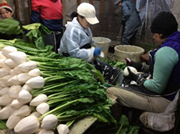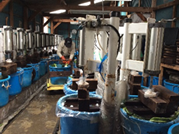Gravity(Attraction) of Kyoto 14 Pottery and Pickles I
 Photo taken on August 8, 2025 Photo taken on August 8, 2025Wakamiya Hachimangu Shrine grounds Gojo Wakamiya Pottery Festival |
 Photo taken on January 30, 2020: Suguki hut at Yasumi Farm Photo taken on January 30, 2020: Suguki hut at Yasumi Farm |
 |
Yoshie Doi
It has long been said that vegetables grown in the soil of places where pottery was developed are delicious, flavorful, and soft. Kyoto is rich in water from Lake Biwa and groundwater, and its Kyoto vegetables are known as a brand. Pottery is also known as a brand, such as Kyo-yaki and Kiyomizu-yaki. The two places share a common thread: soil and water, and the history of Kyoto culture that makes use of them.
On August 8th, I was invited to attend the Pottery Festival and Grand Festival at Wakamiya Hachimangu Shrine in Gojozaka, Higashiyama, Kyoto. The ritual was held solemnly while gagaku music was played, and then the atmosphere was filled with excitement with the taiko drumming.
Pottery vendors set up stalls on Gojo Street, and existing stores also offer special discounts such as 30% off or half off prices, livening up the annual festival. During the Hideyoshi era, Gojo Street was formed by widening the current Matsubara Street southward to form Gojo Street. The original Gojo Street is the current Matsubara Street. Therefore, the battle between Ushiwakamaru and Benkei also took place on the narrow current Matsubara Street.
It has now been revived as the Gojo Wakamiya Pottery Festival after being suspended due to the COVID-19 pandemic. Many people are delighted to see this Kyoto summer tradition return. The Pottery Festival’s roots date back to 1920 (Taisho 9), when it began as a street market selling unsold pottery at low prices to worshippers attending the “Rokudo Mairi (Welcome to the Spirits of the Rokudo Pilgrimage)” held at Rokudo Chinnoji Temple from August 7th to 10th. Since 1954 (Showa 29), it has been the grand festival of Wakamiya Hachiman Shrine. Today, with approximately 400 stalls, it has become one of the largest pottery festivals in the country.
This area is within walking distance of Kiyomizu-dera Temple, Gion, Kyoto National Museum, and Rokudo Chinno-ji Temple, making it a great place to visit and experience the birthplace of Kiyomizu-yaki ware. It is said that the roots of Kiyomizu-yaki lie in Otowaya Kuroemon’s Otowaya kiln, which was opened near Seikanji Temple (Seikanji Yamanouchi-cho, Higashiyama Ward) during the Muromachi period (1449-1452). Otowayaki ware flourished under the patronage of Seikanji Temple, but at the end of the Keicho period (1596-1615), smoke was rising from Toyokuni Shrine on Amida-ga-mine, so the kiln was ordered to be relocated near Kiyomizu-dera Temple. Drawings from the Edo period show smoke rising from Kiyomizu-dera Temple.
Shibazuke, a long-standing pickle made from Kyoto vegetables grown in fertile soil, is said to have originated when Kenreimon-in, who retired to Ohara during the Heian period, received a gift of pickles from her villagers and named them “Shibazuke.” The “Shiba” in question refers to red shiso. Along with sugukizuke and senmaizuke, Shibazuke is considered one of Kyoto’s three major pickles.
In Kyoto, there is a luxurious pickle called senmaizuke, which you wouldn’t think is a pickle at all. Rather than being used for long-term storage, it is a luxury item made with seasonal Shogoin turnips, eaten while they are in season. The story goes that it was invented by Ofuji Tozaburo, a chef at the Imperial Palace, at the end of the Edo period. When he was thinly slicing turnips for senmaizuke in front of his shop, customers remarked, “There are a thousand of them!”, and thus the pickle was named senmaizuke. Senmaizuke became well-known when it was selected for a national ranking of specialties at the National Exposition held in Kyoto in 1890.
Suguki pickles, which have been eaten by aristocrats since the Nara period 1,300 years ago, are one of Kyoto’s three major pickles. Suguki has been cultivated in Kamigamo, Kyoto since the mid-Edo period, and are made into pickles using salt and artisanal techniques, making them a genuine natural food product through lactic acid fermentation.
Commercially available pickles are usually made by pickle shops, but suguki pickles are made and sold wholesale by farmers in Kamigamo who have inherited the same techniques for generations. I was fortunate enough to visit the workshops and fields of these three major pickle producers and hear many stories from the owners. I was deeply impressed by the deep love that the creators had for the roots of these pickles. (Continued in the next issue)
The end of document
Translated by Masami Otani
